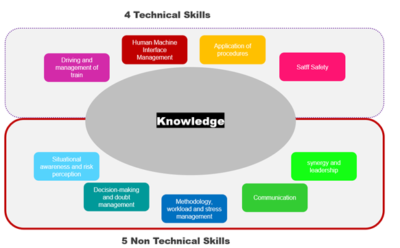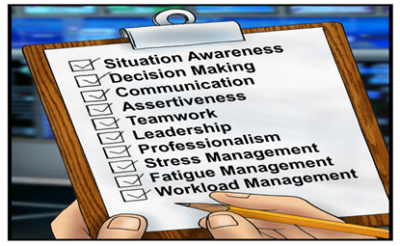Title Language Infographic Flyer Mobile device risk in rail operations English (EN) Web version Print version Das risiko mobiler endgeräte im eisenbahnbetrieb German (DE) Web version Print Version...
Human Performance
About this topic
Introduction
The term Human Performance refers to the contribution that humans make to the performance of a system. It describes how people carry out their work, whether as an individual or as a team, in order to meet a required objective.
From a HOF perspective, human performance is a key focus when considering how a system can be optimised, as well as where it can be vulnerable to failure. When systems are designed to accommodate the capabilities, limitations and skills of the people who utilise them, human performance can ensure those systems are optimized and functioning well. When they are not, human performance can be impacted, and the system becomes vulnerable. Effective systems are tolerant of variation in human performance because they have been designed to anticipate and quickly recover from impacts to human performance – and rail systems are no different.
Relevance to Rail
The rail system relies heavily on human performance, whether it’s to operate rolling stock, to signal trains around the network, to manage network disruption, to keep stations open/ operating, to inspect/ maintain rail assets and to produce/ analyse the data that keeps timetables operational and engineering works well-planned. A high level of human performance keeps trains running to time, disruption low and rail systems performing at their best. History has shown that, as with other safety critical industries, the rail industry is vulnerable when human performance is impaired, and the consequences can be catastrophic. It is important, then, that rail organizations incorporate the need to understand and manage the impacts to human performance into their safety management systems and into their HOF programs.
Approaches and Models
Human performance can be influenced by elements associated with a person, the tasks they are performing and the organization they belong to. These elements are typically referred to as Performance Shaping Factors (PSFs), and include fatigue, workload, situation awareness, stress, physical ergonomics and skills and knowledge. HOF programs within safety critical organizations will typically include a focus on PSFs given the impact they can have on safety and system performance. Understanding and managing the risks associated with PSFs can help reduce the likelihood of human performance being adversely impacted.
There are numerous methods for evaluating human performance and they differ depending on the performance element being considered. Performance is often measured in terms of the volume of output, task accuracy, error rate, timeliness, presence/absence data and injury rate, to provide some examples. The key, though, is in understanding how performance was impacted, and how it can be optimized.
For more information on some of the performance-shaping factors that can impact human performance, take a look at the more detailed topic headers under this section.
The SNCF’s Just & Fair approach
What are the key HOF issues? In 2015, SNCF launched a major safety program (called PRISME) to improve its overall safety performance. As baseline of this program, the company has deployed a Just & Fair (J&F)...
Non-technical skills for the train driver’s job – SNCF Voyageurs
What are the key HOF issues? With the influx of HOF specialists in 2008, the Traction Department (SNCF Voyageurs) has undertaken in-depth work to develop the non-technical skills of train drivers. Our work was based on...
Enhancing the integration of NTS into competence management systems for rail safety-critical roles
What are the key HOF issues? Non-technical skills (NTS) are the cognitive, social and personal resource skills that complement technical skills, and contribute to safe task performance[1]. NTS have been formalised in...
Evaluation of Human Performance – RSSB
What are the key HOF issues? Despite the ongoing efforts from industry to improve safety and performance, there is an indication that we are now seeing diminishing returns in investments into improvements that the rail...
Capturing detailed Human Factors causal data for SPAD events – RSSB
What are the key HOF issues? The Safety Management Intelligence System, known to many as SMIS, is the rail industry’s on-line health and safety reporting and business intelligence software. It collects and provides...
Building a Targeted Fatigue Risk Management System
What are the key HOF issues? This case study describes the application of fatigue risk management (FRM) within a rail transport organization in Melbourne, Australia. What did you do? Metro Trains Melbourne (Metro)...
Read, G.J.M, Shorrock, S., Walker, G.H., Salmon P.M., 2021. State of science: evolving perspectives on ‘human error’. Ergonomics 64, 9, 1091-1114.
Abstract: This paper reviews the key perspectives on human error and analyses the core theories and methods developed and applied over the last 60 years. These theories and methods have sought to improve our...
Reason, J. (1997) Managing the risk of organisational accidents. Ashgate: Farnham.
https://www.taylorfrancis.com/books/mono/10.4324/9781315543543/managing-risks-organizational-accidents-james-reason
International Labour Organization (ILO): Stress prevention at work checkpoints
https://www.ilo.org/wcmsp5/groups/public/@dgreports/@dcomm/@publ/documents/publication/wcms_168053.pdf
OSI Occupational stress Inventory – 1988
Job Content Questionnaire – Karasek 1998
HSE – Free Stress Indicator Tool
https://books.hse.gov.uk/article/654091/Stress-Indicator-Tool/Free-Stress-Indicator-Tool
The WOrking Conditions and Control Questionnaire WOCCQ
http://www.woccq.be/
Copenhagen Psychosocial Questionnaire COPSOQ
https://www.copsoq-network.org/
Psychomotor Vigilance Task Test App – Research Buddies
https://researchbuddies.com/
NASA Psychomotor Vigilance Test
https://apps.apple.com/fr/app/nasa-pvt/id1146834402
Office of Rail and Road Regulation, 2012 – Managing rail staff fatigue
https://www.orr.gov.uk/media/10934
Bowler, N.; Gibson, H. (2015) “Fatigue and Its Contributions to Railway Incidents”
Abstract: This report analyzes a sample of 246 British railroad incidents using data from the Rail Safety and Standards Board (RSSB) Safety Management Information System (SMIS) and Incident Factor Classification System...
Regulation EU 2016/798
https://eur-lex.europa.eu/legal-content/FR/TXT/PDF/?uri=CELEX:32016L0798&from=MT
Pheasant, S. and Haslegrave, C.M. (2018) Bodyspace: Anthropometry, Ergonomics and the Design of Work. CRC Press.
https://www.taylorfrancis.com/books/mono/10.1201/9781315375212/bodyspace-christine-haslegrave-stephen-pheasant
HSE – Assessment of Repetitive Tasks (ART) tool
https://www.hse.gov.uk/msd/uld/art/index.htm
Applications Manual for the Revised NIOSH Lifting Equation (94-110) | NIOSH | CDC
https://www.cdc.gov/niosh/docs/94-110/default.html
International Ergonomics Association: Musculoskeletal Disorder (MSD) Risk Assessment Tools
https://iea.cc/ergonomics-in-practice/tools-for-assessing-and-implementing-hfe-in-the-workplace/
ISO 11228 (Parts 1 – 3) Ergonomics – Manual Handling
https://www.iso.org/standard/26520.html
ISO 11226:2000 Ergonomics – Evaluation of static working postures
https://www.iso.org/standard/25573.html
ISO 7250 (Parts 1 – 3) Basic human body measurements for technological design
https://www.iso.org/standard/65246.html
ISO 6385:2016 Ergonomics principles in the design of work systems
https://www.iso.org/standard/63785.html
NASA Task Load Index
https://humansystems.arc.nasa.gov/groups/tlx/downloads/TLXScale.pdf
Flin. R (2013) “The Power of Behaviour: Non-Technical Skills”
https://www.veiligheidskunde.nl/stream/congres2013p-jan-de-kroes-lecture-the-power-of-behaviour-non-technical-skills-door-rhona-flin
RSSB – Non Technical Skills
https://www.rssb.co.uk/safety-and-health/improving-safety-health-and-wellbeing/understanding-human-factors/non-technical-skills
Videos on Just Culture and Understanding Human Error
https://www.youtube.com/watch?v=Fw3SwEXc3PU
What are non technical skills?
One of the approaches to help minimise errors is the idea of non-technical skills. Technical skills are the skills you learn to be able to do your job – like being able to control the speed of a train or knowing where...
RSSB Training on non-technical skills awareness and integration
A course that builds knowledge of non-technical skills by discussing the risks and challenges faced by organisations.
Why do people make errors?
Whenever something goes wrong, we often hear the label ‘human error’ being applied. Within human factors, human error is the starting point for an investigation, not the end point. Ok, somebody did something wrong, but...
Regulation 2020/572 on the reporting structure to be followed for railway accident and incident investigation reports
Regulation 2020/572 on the reporting structure to be followed for railway accident and incident investigation reports

Mobile device risk in rail operations
Title Language Infographic Flyer Mobile device risk in rail operations English (EN) Web version Print version Das risiko mobiler endgeräte im eisenbahnbetrieb German (DE) Web version Print Version Riesgo de los dispositivos móviles en...
The SNCF’s Just & Fair approach
What are the key HOF issues? In 2015, SNCF launched a major safety program (called PRISME) to improve its overall safety performance. As baseline of this program, the company has deployed a Just & Fair (J&F) approach to create a climate of trust...

Non-technical skills for the train driver’s job – SNCF Voyageurs
What are the key HOF issues? With the influx of HOF specialists in 2008, the Traction Department (SNCF Voyageurs) has undertaken in-depth work to develop the non-technical skills of train drivers. Our work was based on the scientific definition of...
Enhancing the integration of NTS into competence management systems for rail safety-critical roles
What are the key HOF issues? Non-technical skills (NTS) are the cognitive, social and personal resource skills that complement technical skills, and contribute to safe task performance[1]. NTS have been formalised in GB rail since 2012 and progress has...
Evaluation of Human Performance – RSSB
What are the key HOF issues? Despite the ongoing efforts from industry to improve safety and performance, there is an indication that we are now seeing diminishing returns in investments into improvements that the rail industry makes. It is important...
Capturing detailed Human Factors causal data for SPAD events – RSSB
What are the key HOF issues? The Safety Management Intelligence System, known to many as SMIS, is the rail industry’s on-line health and safety reporting and business intelligence software. It collects and provides access to information on thousands of...
Building a Targeted Fatigue Risk Management System
What are the key HOF issues? This case study describes the application of fatigue risk management (FRM) within a rail transport organization in Melbourne, Australia. What did you do? Metro Trains Melbourne (Metro) operates and maintains Melbourne’s...
Read, G.J.M, Shorrock, S., Walker, G.H., Salmon P.M., 2021. State of science: evolving perspectives on ‘human error’. Ergonomics 64, 9, 1091-1114.
Abstract: This paper reviews the key perspectives on human error and analyses the core theories and methods developed and applied over the last 60 years. These theories and methods have sought to improve our understanding of what human error is, and how...
Reason, J. (1997) Managing the risk of organisational accidents. Ashgate: Farnham.
https://www.taylorfrancis.com/books/mono/10.4324/9781315543543/managing-risks-organizational-accidents-james-reason
International Labour Organization (ILO): Stress prevention at work checkpoints
https://www.ilo.org/wcmsp5/groups/public/@dgreports/@dcomm/@publ/documents/publication/wcms_168053.pdf
OSI Occupational stress Inventory – 1988
Job Content Questionnaire – Karasek 1998
HSE – Free Stress Indicator Tool
https://books.hse.gov.uk/article/654091/Stress-Indicator-Tool/Free-Stress-Indicator-Tool
The WOrking Conditions and Control Questionnaire WOCCQ
http://www.woccq.be/
Copenhagen Psychosocial Questionnaire COPSOQ
https://www.copsoq-network.org/
Psychomotor Vigilance Task Test App – Research Buddies
https://researchbuddies.com/
NASA Psychomotor Vigilance Test
https://apps.apple.com/fr/app/nasa-pvt/id1146834402
Office of Rail and Road Regulation, 2012 – Managing rail staff fatigue
https://www.orr.gov.uk/media/10934
Bowler, N.; Gibson, H. (2015) “Fatigue and Its Contributions to Railway Incidents”
Abstract: This report analyzes a sample of 246 British railroad incidents using data from the Rail Safety and Standards Board (RSSB) Safety Management Information System (SMIS) and Incident Factor Classification System (IFCS). Trends in fatigue-related...
Regulation EU 2016/798
https://eur-lex.europa.eu/legal-content/FR/TXT/PDF/?uri=CELEX:32016L0798&from=MT
Pheasant, S. and Haslegrave, C.M. (2018) Bodyspace: Anthropometry, Ergonomics and the Design of Work. CRC Press.
https://www.taylorfrancis.com/books/mono/10.1201/9781315375212/bodyspace-christine-haslegrave-stephen-pheasant
HSE – Assessment of Repetitive Tasks (ART) tool
https://www.hse.gov.uk/msd/uld/art/index.htm
Applications Manual for the Revised NIOSH Lifting Equation (94-110) | NIOSH | CDC
https://www.cdc.gov/niosh/docs/94-110/default.html
International Ergonomics Association: Musculoskeletal Disorder (MSD) Risk Assessment Tools
https://iea.cc/ergonomics-in-practice/tools-for-assessing-and-implementing-hfe-in-the-workplace/
ISO 11228 (Parts 1 – 3) Ergonomics – Manual Handling
https://www.iso.org/standard/26520.html
ISO 11226:2000 Ergonomics – Evaluation of static working postures
https://www.iso.org/standard/25573.html
ISO 7250 (Parts 1 – 3) Basic human body measurements for technological design
https://www.iso.org/standard/65246.html
ISO 6385:2016 Ergonomics principles in the design of work systems
https://www.iso.org/standard/63785.html
NASA Task Load Index
https://humansystems.arc.nasa.gov/groups/tlx/downloads/TLXScale.pdf
Flin. R (2013) “The Power of Behaviour: Non-Technical Skills”
https://www.veiligheidskunde.nl/stream/congres2013p-jan-de-kroes-lecture-the-power-of-behaviour-non-technical-skills-door-rhona-flin
RSSB – Non Technical Skills
https://www.rssb.co.uk/safety-and-health/improving-safety-health-and-wellbeing/understanding-human-factors/non-technical-skills
Videos on Just Culture and Understanding Human Error
https://www.youtube.com/watch?v=Fw3SwEXc3PU

What are non technical skills?
One of the approaches to help minimise errors is the idea of non-technical skills. Technical skills are the skills you learn to be able to do your job – like being able to control the speed of a train or knowing where to look when dispatching a train....
RSSB Training on non-technical skills awareness and integration
A course that builds knowledge of non-technical skills by discussing the risks and challenges faced by organisations.
Why do people make errors?
Whenever something goes wrong, we often hear the label ‘human error’ being applied. Within human factors, human error is the starting point for an investigation, not the end point. Ok, somebody did something wrong, but why? What was it about the person,...
Regulation 2020/572 on the reporting structure to be followed for railway accident and incident investigation reports
Regulation 2020/572 on the reporting structure to be followed for railway accident and incident investigation reports

Mobile device risk in rail operations
Title Language Infographic Flyer Mobile device risk in rail operations English (EN) Web version Print version Das risiko mobiler endgeräte im eisenbahnbetrieb German (DE) Web version Print Version Riesgo de los dispositivos móviles en...
The SNCF’s Just & Fair approach
What are the key HOF issues? In 2015, SNCF launched a major safety program (called PRISME) to improve its overall safety performance. As baseline of this program, the company has deployed a Just & Fair (J&F) approach to create a climate of trust...

Non-technical skills for the train driver’s job – SNCF Voyageurs
What are the key HOF issues? With the influx of HOF specialists in 2008, the Traction Department (SNCF Voyageurs) has undertaken in-depth work to develop the non-technical skills of train drivers. Our work was based on the scientific definition of...
Enhancing the integration of NTS into competence management systems for rail safety-critical roles
What are the key HOF issues? Non-technical skills (NTS) are the cognitive, social and personal resource skills that complement technical skills, and contribute to safe task performance[1]. NTS have been formalised in GB rail since 2012 and progress has...
Evaluation of Human Performance – RSSB
What are the key HOF issues? Despite the ongoing efforts from industry to improve safety and performance, there is an indication that we are now seeing diminishing returns in investments into improvements that the rail industry makes. It is important...
Capturing detailed Human Factors causal data for SPAD events – RSSB
What are the key HOF issues? The Safety Management Intelligence System, known to many as SMIS, is the rail industry’s on-line health and safety reporting and business intelligence software. It collects and provides access to information on thousands of...
Building a Targeted Fatigue Risk Management System
What are the key HOF issues? This case study describes the application of fatigue risk management (FRM) within a rail transport organization in Melbourne, Australia. What did you do? Metro Trains Melbourne (Metro) operates and maintains Melbourne’s...
Read, G.J.M, Shorrock, S., Walker, G.H., Salmon P.M., 2021. State of science: evolving perspectives on ‘human error’. Ergonomics 64, 9, 1091-1114.
Abstract: This paper reviews the key perspectives on human error and analyses the core theories and methods developed and applied over the last 60 years. These theories and methods have sought to improve our understanding of what human error is, and how...
Reason, J. (1997) Managing the risk of organisational accidents. Ashgate: Farnham.
https://www.taylorfrancis.com/books/mono/10.4324/9781315543543/managing-risks-organizational-accidents-james-reason
International Labour Organization (ILO): Stress prevention at work checkpoints
https://www.ilo.org/wcmsp5/groups/public/@dgreports/@dcomm/@publ/documents/publication/wcms_168053.pdf
OSI Occupational stress Inventory – 1988
Job Content Questionnaire – Karasek 1998
HSE – Free Stress Indicator Tool
https://books.hse.gov.uk/article/654091/Stress-Indicator-Tool/Free-Stress-Indicator-Tool
The WOrking Conditions and Control Questionnaire WOCCQ
http://www.woccq.be/
Copenhagen Psychosocial Questionnaire COPSOQ
https://www.copsoq-network.org/
Psychomotor Vigilance Task Test App – Research Buddies
https://researchbuddies.com/
NASA Psychomotor Vigilance Test
https://apps.apple.com/fr/app/nasa-pvt/id1146834402
Office of Rail and Road Regulation, 2012 – Managing rail staff fatigue
https://www.orr.gov.uk/media/10934
Bowler, N.; Gibson, H. (2015) “Fatigue and Its Contributions to Railway Incidents”
Abstract: This report analyzes a sample of 246 British railroad incidents using data from the Rail Safety and Standards Board (RSSB) Safety Management Information System (SMIS) and Incident Factor Classification System (IFCS). Trends in fatigue-related...
Regulation EU 2016/798
https://eur-lex.europa.eu/legal-content/FR/TXT/PDF/?uri=CELEX:32016L0798&from=MT
Pheasant, S. and Haslegrave, C.M. (2018) Bodyspace: Anthropometry, Ergonomics and the Design of Work. CRC Press.
https://www.taylorfrancis.com/books/mono/10.1201/9781315375212/bodyspace-christine-haslegrave-stephen-pheasant
HSE – Assessment of Repetitive Tasks (ART) tool
https://www.hse.gov.uk/msd/uld/art/index.htm
Applications Manual for the Revised NIOSH Lifting Equation (94-110) | NIOSH | CDC
https://www.cdc.gov/niosh/docs/94-110/default.html
International Ergonomics Association: Musculoskeletal Disorder (MSD) Risk Assessment Tools
https://iea.cc/ergonomics-in-practice/tools-for-assessing-and-implementing-hfe-in-the-workplace/
ISO 11228 (Parts 1 – 3) Ergonomics – Manual Handling
https://www.iso.org/standard/26520.html
ISO 11226:2000 Ergonomics – Evaluation of static working postures
https://www.iso.org/standard/25573.html
ISO 7250 (Parts 1 – 3) Basic human body measurements for technological design
https://www.iso.org/standard/65246.html
ISO 6385:2016 Ergonomics principles in the design of work systems
https://www.iso.org/standard/63785.html
NASA Task Load Index
https://humansystems.arc.nasa.gov/groups/tlx/downloads/TLXScale.pdf
Flin. R (2013) “The Power of Behaviour: Non-Technical Skills”
https://www.veiligheidskunde.nl/stream/congres2013p-jan-de-kroes-lecture-the-power-of-behaviour-non-technical-skills-door-rhona-flin
RSSB – Non Technical Skills
https://www.rssb.co.uk/safety-and-health/improving-safety-health-and-wellbeing/understanding-human-factors/non-technical-skills
Videos on Just Culture and Understanding Human Error
https://www.youtube.com/watch?v=Fw3SwEXc3PU

What are non technical skills?
One of the approaches to help minimise errors is the idea of non-technical skills. Technical skills are the skills you learn to be able to do your job – like being able to control the speed of a train or knowing where to look when dispatching a train....
RSSB Training on non-technical skills awareness and integration
A course that builds knowledge of non-technical skills by discussing the risks and challenges faced by organisations.
Why do people make errors?
Whenever something goes wrong, we often hear the label ‘human error’ being applied. Within human factors, human error is the starting point for an investigation, not the end point. Ok, somebody did something wrong, but why? What was it about the person,...
Regulation 2020/572 on the reporting structure to be followed for railway accident and incident investigation reports
Regulation 2020/572 on the reporting structure to be followed for railway accident and incident investigation reports
Join us
Are you interested in HOF?
Do you want to learn about Human & Organisational Factors? Safety culture, non-technical skills, health and safety, more?
Join us on this international and diverse network which captures in one place the valuable and enriching information and material, either academic or practical railways-oriented, on the organizational and human factors that you need.
Are you involved in HOF activities?
You want to learn about Human & Organisational Factors? Safety culture, non-technical skills, health and safety, more?
Join us on this international and transversal network which capitalizes the valuable and enriching information and material, either academic nor Railways oriented, on the organizational and human factors that you need.
Are you an HOF expert?
Are you a Rail Human and Organisational factors expert, a Rail Safety expert, a Railway Head of safety, or other? This space is made for you. Here, you have access to confidential information and can even create or participate in a discussion forum to initiate conversations and exchanges with your peers.
